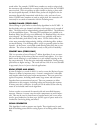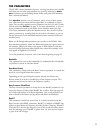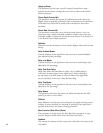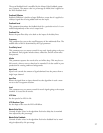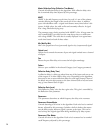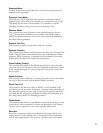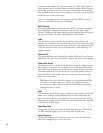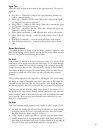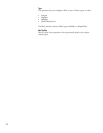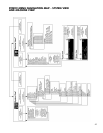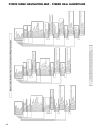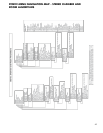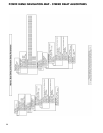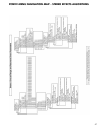41
Signal Type
Selects the type of signal to be created by the signal generator. The types of
signal are:
• Sine Wave — When this is selected the signal frequency parameter is
used to control frequency.
• Sweep Up — 20Hz to 20KHz sweep. When this is selected the signal
rate parameter is used to control rate.
• Sweep Down — 20Khz to 20Hz sweep. When this is selected the signal
rate parameter is used to control rate.
• Pink Click — Broadband impulse. When this is selected the signal rate
parameter is used to control rate.
• White Noise (correlated) — sends identical white noise to all outputs
• White Noise (decorrelated) — sends decorrelated white noise to all out-
puts.
• Pink Noise (correlated) — sends identical pink noise to all outputs
• Pink Noise (decorrelated) — sends decorrelated pink noise to all out-
puts.
Spread (Early Spread)
The spread parameter is closely tied to the Shape parameter. Spread is a win-
dow of time during which a signal is injected into the reverb. Shape controls
just how the signal is injected during this window.
Tail Width
This parameter is present in all stereo reverbs and rooms. The reverb tail (all
components of the reverb except for early reflections, etc.) is passed through
a simple 2x2 matrix. This provides an encoding of the tail that dramatically
changes its spatial characteristics. The tail can be changed to feel narrower
(even down to mono) or wider than normal stereo. There are values for the
parameter to encode the tail in such a way that it decodes into surround
channels.
The parameter operates in the range of 0 to 360 degrees, with an incremen-
tal change of 1 degree. The matrix uses Sine/Cosine rules so that power dis-
tribution remains constant. This may be acceptible—even highly desirable—
but the mix engineer must fully understand the process and its implications.
This is a powerful tool for audio whose release format is two-channel. It is
not useful in any other format. Formats include compact disc and radio/tele-
vision broadcast. Some of these effects are clear and noticeable without any
sort of decoder. Many are even more dramatic when a decoder is in place,
such as in a home theater.
Tap Slope
This is an extremely subtle parameter and is useful in only a couple of cases:
• For halls and reverbs with relatively long reverb times, the slope should
be slightly positive (0.2 or so). For rooms with very short reverb times,
the slope should be slightly negative (-0.2 or so).
• Using a reverb to create a gate effect or to create a pseudo-room sound.
MidRT should be at 0. Spread should be fairly high. Shape should be
fairly high. Size should be fairly high. TapSlope should be in the range of
(0.5 to 1.0). Play with spread, shape and size to vary the effect.



